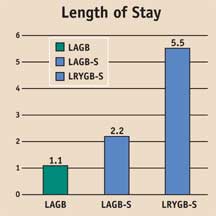
When it comes to any surgical procedure, experience is key to the likelihood of a successful outcome. This is especially true for innovative, newer procedures.
One of these procedures is the Lap-Band System, a minimally invasive weight loss surgery. During this procedure, an adjustable gastric band is placed around the stomach to reduce the amount of food a patient can eat. This is accomplished using very small incisions and specially designed instruments.
The Lap-Band has been gaining in popularity among individuals who unsuccessfully have tried many other weight loss options. It¹s considered to be less invasive and drastic than gastric bypass surgery. When a new procedure starts to become mainstream, many physicians jump on the bandwagon and begin offering it to their patients, often without extensive training and experience.
Fortunately for patients in central Illinois, the surgeons of Peoria Surgical Group rank among the top 10 in Lap-Band practices as determined by the number of bands placed in patients. As such, we¹ve gathered data on the results of our own patient outcomes as they compare to national studies.
Why Lap-Band?
When comparing the results of our patients to previously published studies, we found local results have been either comparable or superior. Groups are defined as follows:
- RNY: 675 Laparoscopic Roux-n-Y gastric bypass patients (published
studies). - LAP-S: 1,054 Lap-Band patients (published studies).
- LAP-L: 90 Lap-Band patients (local results).
Of course, the positive outcome of local results should help patients feel comfortable about their decision to have this life-changing surgery performed in central Illinois. However, there may still be questions about choosing Lap-Band over the more traditional gastric bypass. For many people, the benefits of pursuing the Lap-Band System significantly outweigh those of gastric bypass.
Yet, certain patients aren¹t appropriate candidates for the Lap-Band and should, at the direction of a qualified physician, consider gastric bypass. As with any medical procedure, an experienced surgeon can help an individual determine which treatment is most suitable for their health, weight, and various other factors.
 Advantages
Advantages
It¹s been found that the Lap-Band System provides effective and consistent weight loss with a low complication rate. Compared to Roux-en-Y gastric bypass, the Lap-Band procedure involves less tissue handling, no intestinal rerouting, and no cutting or stapling of the stomach or bowel. Another factor is that time spent in surgery is typically about one hour, which is less than the time required for gastric bypass.
Other key benefits include a shorter hospital stay (see graph) and fewer complications. There¹s a low risk of nutritional deficiencies, no risk of malabsorption, and no risk of hair or teeth loss. Of major importance is the elimination or reduction of pre-existing conditions such as diabetes, high blood pressure, and other co-morbidities.
Because it¹s adjustable, it supports future pregnancies or other changes in nutritional needs. The adjustments are made easily without additional surgery. The Lap-Band also is reversible if that becomes necessary.
Disadvantages
One of the key disadvantages is that Lap-Band success is 80 percent dependent on the patient¹s commitment to follow up every six to eight weeks for the first post-op year. Individuals who¹ve undergone Lap-Band surgery also must relearn how to eat, including severely limiting or eliminating the consumption of high-calorie liquids such as soda and alcohol.
Every procedure has potential complications. For the Lap-Band, the most commonly reported ones include edema (swelling of soft tissues as the result of water retention), temporary delayed emptying of the stomach, port/tubing leak (the opening used for adjustments), band slippage, or infection.
Complications were comparable between the Lap-Band study group and our local Lap-Band patients. Both Lap-Band groups reported fewer and less severe complications than the Roux-en-Y gastric bypass study group.
Lap-Band Candidates
There are a few key factors that serve as general guidelines for patients who may be appropriate candidates for the Lap-Band System. These include being at least 75 pounds overweight, having a Body Mass Index (BMI) of more than 40, or having a BMI of 35 along with other related medical problems‹high blood pressure, diabetes, etc. Your primary care physician or a Lap-Band surgeon can help you determine if this procedure is appropriate for your condition.
One question that often comes up is the cost. Fortunately, there are several options for funding this life-changing procedure. In some cases, insurance will cover the surgery because of the effects the patient¹s current weight has on his or her overall health. If that isn¹t possible, some patients take advantage of financing programs designed specifically for health care needs. These options are worth considering for individuals suffering from excess weight. TPW
